The Glock has been around for a long time, it’s an established platform that is time tested, AK-like reliable, has as many accessories and 3rd party parts as an AR, and a commanding market share in Law Enforcement of 65% saturation. There’s only one small problem, the Glock you buy today is nearly identical to the Glock you could buy back in the 80’s when it was first introduced. Sure the grip design has changed a bit, not so much the overall form factor, but the stippling, finger groves and a back strap, and the Glock now sports a double recoil spring. The look and design, however, has remained the same. Not only that, but the price has stayed the same, if not increased, despite having moved a factory into the US. While I understand that the name and history may demand that price, that hubris is allowing a host of other companies from outside as well as inside the US come up with products that are of the same or better quality for a much better price. One of those companies who, I think, is looking to directly compete with Glock is Canik with their TP9 SA, the updated version of their original TP9 offering (and they were able to make those upgrades within a year by the way).
Canik is a subdivision of Samsun Yurt Savunma, a military contractor that would be analogous to Lockheed Martin, so they have quite a bit of experience building high quality, military grade equipment and it definitely shows in the TP9. The TP9 looks like an alloy, a combination of several nice guns. The slide looks like a take off from an M&P 9, the lower looks like a P99 and then Canik uses the take down tabs design of the Glock, except makes it not suck.
Opening up the Canik box is like opening a bunch of presents all at once on Christmas.
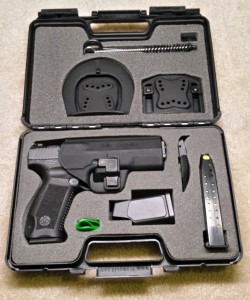
In the top half of the clam shell, there is a 9mm bore brush and a patch rod, underneath there are two mounting options for the supplied holster, both a paddle and a belt loop. Moving into the bottom there is the spare 18 round magazine, backstrap, magazine loader and some odd quality control rubber thingy…OH yeah, then there’s the TP9, itself, within the holster body. The holster is a standard Fobus style paddle release holster and holds the TP9 very securely.
Starting at the top, the Canik has 3 dot with a line sights.
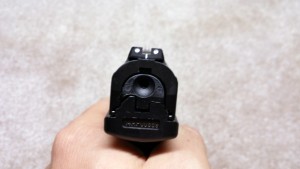
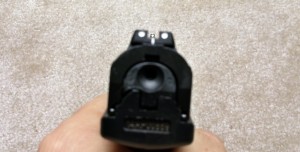
I happen to like the center line on the rear sights as it allows you to make a lollipop with the front sight so it seems easier to line things up for more precise shooting.
Moving forward is the decocker, a nice feature to have on a striker fired gun, and the loaded chamber indicator, which when a bullet is in the chamber, it raises up to give tactile and visual notice that you’ve got something in there.
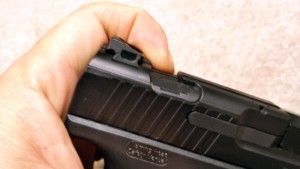
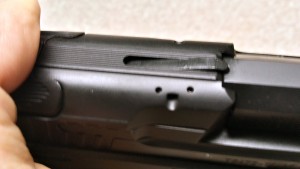
On the left hand side, just above where your thumb would go if you’re right handed, and recessed into the frame is the slide stop. It doesn’t stick out like on other pistols, in fact, nothing on the Canik sticks out from the frame, which keeps it nice and sleek.
Below the chamber, on both sides, are the take down tabs. The Canik’s takedown is leaps and bounds beyond Glocks little finger nail destroyers. They are wide, textured, and the only thing you have to do to take down the Canik is to pull the trigger or decock it and pull the tabs down. That’s it. There’s no partial pull back, do a pirouette and hope for the best, you just pull them down and the slide comes off. I love it.
The innards of the slide are very similar to other types of semi-auto pistols, however, it is nice that there is a channel to insert the recoil spring assembly, instead of a simple indexing hole.
Moving on to the lower, out of the box, the Canik has a much better trigger than a Glock. The take up before the single stage wall is lighter as well as the actual breaking point, though the Glock take up is actually smoother and the striker hits with more authority. The Canik’s trigger feels, not gritty, but grippy at first, and you can see here when the transfer bar is actuated.
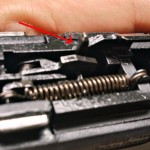
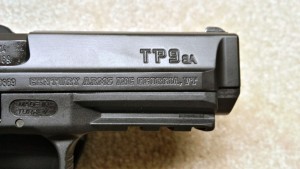
There was a bit of friction between the bar and the frame, causing it to grab slightly, but it has smoothed itself out with time. There is a small detail that not many people who have reviewed this pistol may have noticed. If you look closely, you can see that the rail actually angles down 1, maybe 2 degrees from the barrel. I’m not quite sure the logic behind not having the stream of the light or laser being parallel with the barrel, but I’m sure there’s a good reason.
Whoever designed the grip of the Canik deserves an award. On the Glock, you are very aware that you are wrapping your hand around a handle and consciously adjusting your hand for the best grip. When you take ahold of the Canik grip, it feels effortless, the half-beavertail slips over and indexes itself on the pocket between your thumb and forefinger and the groves on either side guide each digit to exactly where they need to go for a proper shooting hold. Though the width of the grips are identical, the Canik’s profile is slimmer in front and back, which makes it easier to wrap your other fingers around.
Racking the slide on both the Glock and the Canik reveals a huge difference in quality. Though no one can deny that the Glocks are extremely reliable, cycling the slide feels much like cycling the bolt on an AK, it’s loud and clunky and feels like it has loose tolerances (which is, again, why AK’s are so reliable in the first place).
Racking the slide on the Canik is a different experience altogether. It feels smooth as silk. There’s no mechanical stiffness or clunkiness, it just glides back and forth and feels much more solid.
The Canik has one more one-up on Glock, and that is in the magazine. While standard Glock 17 magazines take 17 rounds, the Canik’s take 18. However, and that’s a big however, trying to jam that 18th round into the magazine is quite a chore, even with the supplied mag loader. There is another critique I have of the magazine, though I don’t know if it’s entirely Canik’s fault. When the second generation was first announced, it ‘got out’ that the Canik would be using standard M9 pattern magazines. As youtubers sootch00 and mrgunsandgear have pointed out, the M9 magazines will fit into the magwell, but will not lock in as the magazine catch is located in a different spot. I wanted to check and see if there were any other possible similarities, so I picked up a Mec Gar (the same manufacturer of the magazine) +2 M9 base plate to see if I could get the Canik to 20 rounds. While it did slip over the base of the magazine, the magazine profile was such that it would not lock into place. I was able to jam in 20 rounds, but any forward pressure on the base plate resulted in rounds flying out the bottom. In summary, I don’t know how the M9 magazine rumor got out, but if Canik were to do something nice for owners of both pistols, having magazine compatibility would be it.
So, how can the Canik TP9 become a ‘Glock killer’? Well, they’re starting out by beating them in price. Current, and probably this model of TP9, can be had from $309-$320 online, brand new, with everything in the package. Gen 4 Glocks go for $200+ more than that. That is a HUGE advantage to the Canik, because they have a much better quality gun and all the accessories you need to enjoy your shooting experience in one nice, affordable package. Here is the one problem, Glock has all the accessories. All of them. There are dozens of third party manufacturers that make barrels, conversion kits, magazines, magazine base plates, sights, lasers, lights, any accessory you can think of, specifically for Glock.
While the Canik seems to be a superior pistol, there is almost no aftermarket support. Canik recently announced that they plan on coming out with a .40 S&W version and my immediate thought went to the Glock 22 and how it can be converted not only to .357 Sig, but also to 9mm. If Canik were extremely smart and aggressive, I would suggest that instead on making 2 or 3 separate firearms, that they make one frame that can handle 3 or 4 different calibers. 3rd party manufacturers have proven that with the simple swap of a barrel, you can go from .40 to .357 Sig, to 9, even .22lr, and keep the same reliability. So I would highly encourage Canik to reach out to different contractors such as Lone Wolf Distributors or Advantage Arms, or any number of companies that are dedicated to making aftermarket parts and start building a brand that has the potential to take a huge chunk out of the Glock market share, because if there is any gun that has the potential to do so, this would be one.
And now I am faced with an extremely unfortunate decision. My bank account is light, I want to keep the Canik… I just may have to sell my Glock.
Watch the accuracy comparison between the Canik and the Glock below:
UPDATE: Mec Gar Baretta 92fs +2 Mag extensions do work on the Canik magazines, bringing the round count up to 20, and can be found here: http://gregcotellc.com/cart/index.php?main_page=product_info&products_id=841

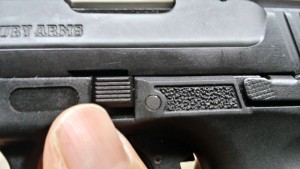
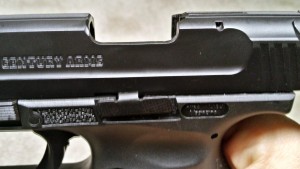
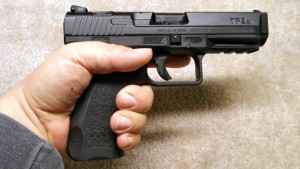
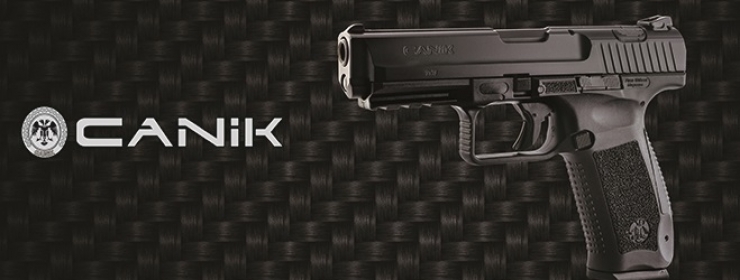
You must be logged in to post a comment.